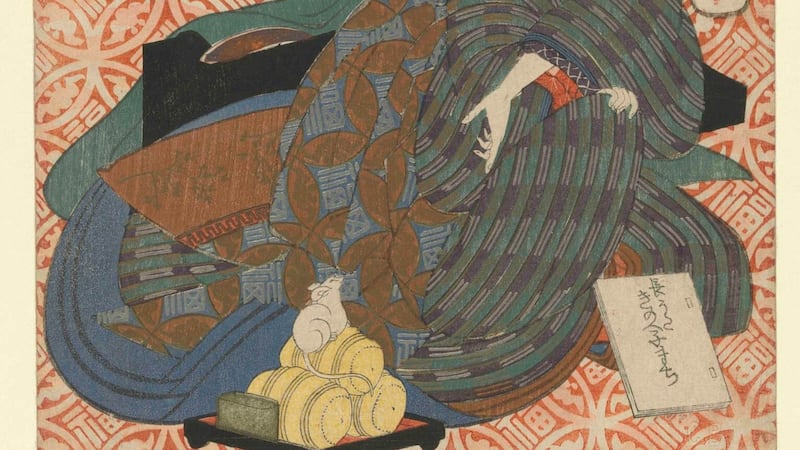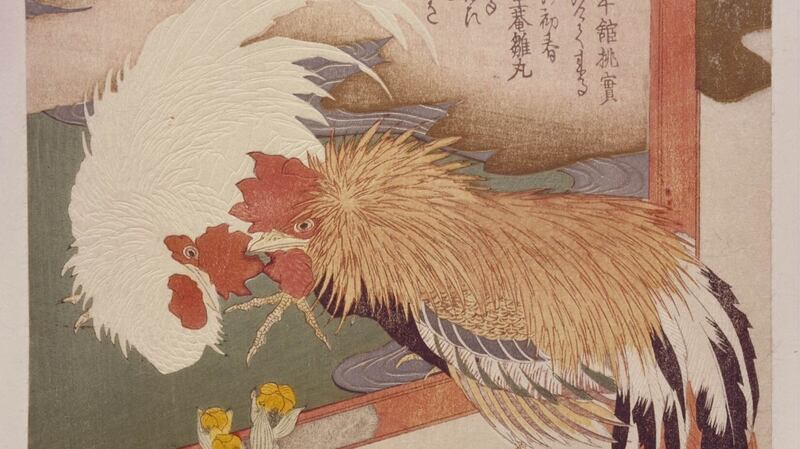The Art of Friendship: Japanese Surimono Prints
Chester Beatty Library, Dublin Castle
*****


When the Japanese woodblock prints known as ukiyo-e, or pictures of the floating world, began to appear in Europe early in the 19th century, they were not widely circulated. By the time Japan's economic and cultural isolationism was formally lifted in 1854, the prints had already gained a wider audience but were still generally regarded as being inferior to Western art. Not only were they printed on flimsy paper – there are several accounts of prints, including Hokusai's printed sketchbooks, being used as wrapping for shipments of porcelain – they were also challenging to eyes familiar with local visual conventions.
That changed as more artists encountered, acquired and studied them. Most of the qualities that set them apart from European art were quickly assimilated by some of the leading impressionists and post-impressionists and their contemporaries. Flattened perspective, areas of even, vivid colour, oblique and truncated compositions, and everyday subject matter all became integral to contemporary Western art. Enthusiasts included Edgar Degas, Mary Cassatt, Édouard Manet, Vincent Van Gogh and James McNeill Whistler, but the impact of Japanese prints extended way outside the work of individual artists, into the wider cultural fabric.
Beyond ukiyo-e, there was a whole other layer of Japanese printmaking in the late 18th and early 19th century: surimono. The word translates as “printed things”, and they were non-commercial, privately commissioned prints, incorporating verse and made for exchange between friends in poetry circles. The verses were kyoka – “wild poetry” – holding to a 31-syllable form. “Reworking lines from the classics or casting a whimsical eye over the everyday,” Mary Redfern explains: “Kyoka are by turn playful, witty and knowing.” She has curated a visually sumptuous exhibition of surimono drawn from the outstanding collection of the Chester Beatty Library.
Beatty was a passionate collector. Sure of his own taste, he had a healthy respect for expertise. When it came to consolidating a representative collection of Japanese prints in the 1950s, he enlisted the advice of an expert, Jack Hillier, generally recognised as the leading authority in Europe – and a self-taught one at that. But that was only part of the story. Back in 1917, recovering from a potentially fatal dose of Spanish flu, Beatty had travelled to Japan, acquired a number of superb painted albums and scrolls and gained a high regard for Japanese artistic prowess.
He was much slower to warm to woodblock prints, though he could have purchased many at any stage. Redfern details how, in 1954, Beatty was offered the chance to purchase an entire collection, that of Dr M Cooper. It comprised a treasure trove of Japanese prints, augmented by additions from the dealer handling the sale. Beatty dithered. His librarian JVS Wilkinson, he noted in a letter to a fellow collector, had “gone ‘crackers’ about Japanese prints . . . it only remains for me to go ‘crackers’”. Crackers or not he eventually took the plunge and, for £4,250, which he considered a high price, he acquired “Approximately 620 . . . Japanese Colour Prints”. Around this time he approached Hiller and asked him “to refine the collection and secure some additional works as required”.
Among the 620 prints were 84 surimono. Hillier advised him to add Japanese printed books as well as prints by under-represented artists. Beatty singled out Hokusai as desirable. Beyond that, he always prioritised the quality and condition of work in the collection. They could sell as well as buy work, upping the quality while bringing down the overall quantity.
When a selection of his Japanese prints was exhibited at Trinity College in May 1955, a small number or surimono were included almost as an afterthought. But by year's end, writing to Wilkinson, he had revised his thinking and strategy: "I think we might go all out for surimono and make the collection famous for surimono, as we cannot compete with the other things." He had realized that, while it would be hard to make a mark in the popular field of collections of ukiyo-e, surimono were less well known and, as he came to appreciate, often of breath-taking quality.
That quickly becomes apparent if you visit the exhibition. Small in scale, amazingly flexible in form, surimono require close attention, but the rewards are immense. Subtleties abound, not only in the nuanced use of colour – as many as 10 blocks might be used for a single print, with an additional, calligraphic block for text – but also, for example, the complex, look-again use of embossing and other flourishes. Usually, higher quality, thicker paper was used than for commercial ukiyo-e.
The technical virtuosity of the images is a given. More surprising, perhaps, is that these sophisticated works, entailing impressive levels of creative ingenuity and limitless attention to detail, were produced within and for groups. These groups might be large but could also be quite small. They were mostly male but women, Redfern notes, were involved with the poetry groups as well. There is often a startling freshness and modernity to the elegance of their design. Many individual artists, including Hokusai, are clearly identifiable in terms of their characteristic style, and the overall quality is, as Beatty would have wished, excellent.
Incidentally, for more of Hokusai, indeed to see some of the sketchbooks that may have been used as wrapping paper in the 19th century, you can visit Manga Hokusai Manga in Trinity (Trinity Long Room Hub, Arts and Humanities Research Institute, until April 1st). The Japanese flair for graphic design evident in ukiyo-e and surimono undoubtedly contributed to the more recent development of manga comic books. 15 volumes of Hokusai's sketchbooks are on display, together with responses to his work by seven contemporary manga artists, allowing us to contemplate the connections and differences involved.
Until August 27th cbl.ie












